University of Alabama
| The University of Alabama | |
|---|---|
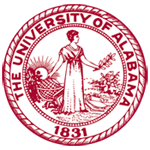 |
|
| Established | 1831 |
| Type | Public University |
| Endowment | $535,305,247 as of 9/30/2008[1] |
| President | Dr. Robert E. Witt |
| Academic staff | 1,122 |
| Students | 28,807[2] |
| Undergraduates | 21,064[2] |
| Location | Tuscaloosa, Alabama, United States |
| Campus | Urban (small city); 1,000 acres (4 km²) |
| Athletics | 19 Varsity Sports 25 Club Sports |
| Colors | Crimson & White |
| Nickname | Crimson Tide |
| Mascot | Big Al |
| Affiliations | Southeastern Conference (NCAA Division I) |
| Website | ua.edu |
 |
|
The University of Alabama (also known as Alabama, UA, or colloquially as 'Bama) is a public coeducational university located in Tuscaloosa, Alabama, USA. Founded in 1831, it is the flagship university of the University of Alabama System. Within Alabama, it is often called "the Capstone". UA is the senior and the largest in terms of enrollment of the state's major research universities, the others being rival Auburn University and fellow UA System institutions the University of Alabama in Huntsville (UAHuntsville) and the University of Alabama at Birmingham (UAB).
The University of Alabama offers programs of study in 12 academic divisions leading to bachelor's, master's, Education Specialist, and doctoral degrees. The only publicly-supported law school in Alabama is at UA. Other academic programs unavailable elsewhere in Alabama include doctoral programs in anthropology, library and information studies, metallurgical engineering, music, Romance languages, and social work.
As of fall 2009, Alabama has an enrollment of close to 29,000 students. Its president is Dr. Robert Witt. Under his leadership, the University has experienced significant growth, despite lower admission acceptance rates, and higher academic standards. The UA Honors Program has grown rapidly as well, with one in five freshmen now enrolled in UA’s Honors College. In fall 2007, these 1,065 scored in the top 2 percent nationally on the ACT.[3]
Contents |
History
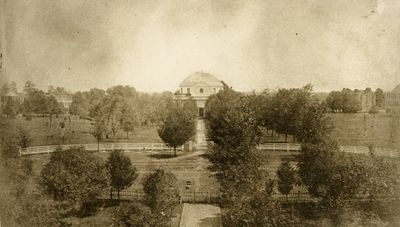
In 1818, Congress authorized the newly created Alabama Territory to set aside a township for the establishment of a "seminary of learning". When Alabama was admitted to the Union on December 14, 1819, a second township was added to the land grant, bringing it to a total of 46,000 acres (186 km²). The General Assembly of Alabama established the seminary on December 18, 1820, named it "The University of the State of Alabama", and created a Board of Trustees to manage the construction and operation of the university. The board chose as the site of the campus a place which was then just outside the city limits of Tuscaloosa, the state capital at the time. The new campus was designed by William Nichols, also the architect of newly completed Alabama State Capitol building and Christ Episcopal Church. Influenced by Thomas Jefferson's plan at the University of Virginia, the Nichols-designed campus featured a 70-foot (21 m) wide, 70-foot (21 m) high domed Rotunda that served as the library and nucleus of the campus.[4] The university's charter was presented to the first university president in the nave of Christ Episcopal Church. Alabama opened its doors to students on April 18, 1831, with the Reverend Alva Woods as President.
An academy-style institution during the Antebellum period, the university emphasized the classics and the social and natural sciences. There were around 100 students per year at UA in the 1830s. However, as Alabama was a frontier state and a sizable amount of its territory was still in the hand of various Native American tribes until the 1840s, it lacked the infrastructure to adequately prepare students for the rigors of university education. Consequently, only a fraction of students who enrolled in the early years remained enrolled for long and even fewer graduated. Those who did graduate, however, often had distinguished careers in Alabama and national politics. Early graduates included Benjamin Porter and Alexander Meek.
As the state and university matured, an active literary culture evolved on campus and in Tuscaloosa. UA had one of the largest libraries in the country on the eve of the Civil War with more than 7,000 volumes. There were several thriving literary societies, including the Erosophic and the Phi Beta Kappa societies, which frequently had lectures by such distinguished politicians and literary figures as United States Supreme Court Justice John A. Campbell, novelist William Gilmore Simms, and Professor Frederick Barnard (later president of Columbia University).
Discipline and student behavior was a major issue at the university almost from the day it opened. Early presidents attempted to enforce strict rules regarding conduct. Students were prohibited from drinking, swearing, making unauthorized visits off-campus, or playing musical instruments outside of a one-hour time frame. Yet riots and gunfights were not an uncommon occurrence. To combat the severe discipline problem, president Landon Garland lobbied and received approval from the legislature in 1860 to transform the University into a military school. As such, many of the cadets who graduated from the school went on to serve as officers in the Confederate Army during the Civil War. As a consequence of that role, Union troops burned down the campus on April 4, 1865, which was unrelated to Sherman's March to the Sea several months earlier and farther east, in Georgia. Only four buildings survived the burning: the President's Mansion (1841), Gorgas House (1829), Little Round House (1860), and Old Observatory (1844).[4]

The University reopened in 1871 and in 1880, Congress granted the university 40,000 acres (162 km²) of coal land in partial compensation for $250,000 in war damages. The military structure was dropped approximately a decade after the school was officially opened to women in 1892 after much lobbying by Julia Tutwiler to the Board of Trustees. Tutwiler Hall, the largest women's residence hall on campus, is named in her honor.
On June 11, 1963, Governor George Wallace made his infamous "Stand in the Schoolhouse Door". He stood in the front entrance of Foster Auditorium in a symbolic attempt to stop the enrollment of two African Americans: Vivian Malone and James Hood. When confronted by US Deputy Attorney General Nicholas Katzenbach and federal marshals sent in by Attorney General Robert F. Kennedy, Wallace stepped aside. President John F. Kennedy had called for the integration of the University of Alabama as well.[5] Although Hood dropped out of school after two months, he subsequently returned and, in 1997, received his Ph.D. in philosophy. Malone persisted in her studies and became the first African American to graduate from The University. In 2000, The University granted her a doctorate of humane letters. Later in his life, Wallace apologized for his opposition at that time to racial integration.
Academic divisions

The eight divisions of The University granting undergraduate degrees are:
- College of Arts and Sciences
- Culverhouse College of Commerce and Business Administration
- College of Communication and Information Sciences
- College of Education
- College of Engineering
- College of Human Environmental Sciences
- Capstone College of Nursing
- School of Social Work
Degrees in those eight divisions at the master's, specialist, and doctoral level are awarded through the Graduate School.
The School of Law offers J.D. and LL.M. degree programs. The College of Community Health Sciences provides advanced studies in medicine and related disciplines and operates a family practice residency program. Medical students are also trained in association with the University of Alabama School of Medicine. Finally, the College of Continuing Studies provides correspondence courses and other types of distance education opportunities for non-traditional students. It operates a distance education facility in Gadsden.
Founded in 1971 and merged into the College of Arts and Sciences in 1996, the New College program allows undergraduate students more flexibility in choosing their curriculum while completing a Bachelor of Arts or Bachelor of Sciences degree. The program allows students to create a "depth study" in a particular field chosen by the student. The student completes approved independent studies alongside their normal coursework. The objective of New College is to inspire interdisciplinary learning at the undergraduate level.
Campus

UA is composed of a singular campus of approximately 1,800 acres (4 km²). The campus is notable for its abundance of buildings built in the Greek Revival style. Four University of Alabama buildings survived the Civil War: Gorgas House, Maxwell Hall (the Old Observatory), the Little Round House (Civil War lookout post), and the President's Mansion. All are still used today.
Landmarks include the President's Mansion, the Amelia Gayle Gorgas Library, and Denny Chimes, a campanile equipped with a 25-bell carillon, all of which are located on or near the Quad, the central green on campus. The Quad lies roughly at the geographic center of the campus.
On-campus cultural facilities include the Paul Bryant Museum, the Alabama Museum of Natural History, the Allen Bales Theater, the Marion Gallaway Theater, the Sarah Moody Gallery of Art, Morgan Auditorium, and the Frank M. Moody Music Building,[6] which houses the Tuscaloosa Symphony Orchestra and the UA Opera Theatre, as well as three resident choirs.
The University also maintains The University of Alabama Arboretum in eastern Tuscaloosa and the Dauphin Island Sea Lab on Dauphin Island.
Layout
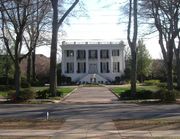
The Quad anchors the campus. To the east lie buildings housing most of the science and math departments, as well as the College of Nursing. Engineering Row, home of the departments of the College of Engineering, is located to the northeast, and the fine arts and humanities departments of the College of Arts and Sciences are oriented to the north and northwest of the Quad. To the west lie the buildings of the colleges of Commerce and Education. Finally, the College of Communication and Information Sciences, the College of Human Environmental Sciences, and the School of Social Work flank the Quad to the south.
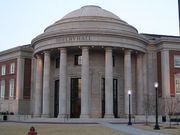
Additionally, the facilities of the School of Law, the School of Music (a division of the College of Arts and Sciences), and the College of Community Health Sciences are located in the far eastern edge of campus. The College of Continuing Education is located in Parham Hall further south of the Quad.
Athletic facilities generally flank the far south edge of campus. Bryant-Denny Stadium is in the southwestern edge of the campus and Coleman Coliseum is in the southeastern edge of campus, near the law school.
The entire campus is served by the CrimsonRide shuttle bus system, which officially started serving campus on August 11, 2007.[7]
Demographics
As of the fall semester of 2008, The University has a total enrollment of 28,807 undergraduate, professional, and graduate students.[8] Enrollment demographics for 2008: 76% are residents of Alabama and 24% are out-of-state students. 81% of students are white, 11% are African-American and 2% are Hispanic.[9]
In figures from 2005, the most recent available, The University had a faculty of 1,148. 829 held the rank of assistant professor or higher. 922 faculty members were full time. 527 were tenured with 244 on tenure track. 13.8% (114) were minorities and 34.7% (287) were women.
Capital Campaign
In April 2006, the University announced a capital campaign with a goal of $500 million called "Our Students. Our Future."[10] The "quiet phase" of the campaign, which started in 2002, raised $299 million. The focus of the campaign, to end in 2009, was stated to be "student scholarships, faculty support, campus facilities and priority needs." In November 2007, the University announced that it had raised $428 million.[11]
This campaign will add approximately $250 million to the endowment,[12] valued at over $535 million as of September 2008.[1]
Half of the money raised in the capital campaign will go toward student financial aid to recruit and retain students. So far more than $170 million has been allocated to student financial aid. Endowed scholarships account for $75 million.
An additional $77 million has been donated to buildings and facilities. The athletics department and the UA School of Law have raised substantial amounts of money for building purposes.
Rankings and Accolades
| USNWR National University[13] | 79 |
|---|
General
The University of Alabama has consistently ranked as a top 50 public university in the nation by U.S. News & World Report and has a selectivity rating of "more selective".[14] In the 2011 US News and World Report, UA is ranked 79th among all colleges in the nation.[15] The University of Alabama ranked 12th in the nation among public universities in the enrollment of National Merit Scholars in 2007. Seven University of Alabama students were named to the 2008 USA Today All-USA College Academic Team, the most of any school. This year’s team brings UA’s total for the last six years to 31, a figure that tops all other colleges and universities. In addition to this year, UA had the most students on the list in 2006 with six and in 2005 and 2003, both with five. In 2007, UA tied with Washington University-St. Louis for the most team members with four. In 2004, with four students on the team, UA came in second only to Harvard.[3]
A ranking of colleges and universities, published in the May 19, 2008 edition of Forbes magazine, ranks the University of Alabama seventh in the nation among public universities. The ranking also places UA 42nd among all national universities, both public and private.[16] According to both the 2008 and the 2009 US News and World Report America's Best Colleges Edition college rankings, UA had the highest ranking of any university in the state of Alabama.[17] In fact, among all public universities in the US, the University of Alabama is ranked #37, according to the 2009 USNWR America's Best Colleges Edition, up from its national ranking of #41 the previous year.
UA graduates include 15 Rhodes Scholars, 15 Goldwater Scholars, nine Truman Scholars, one Gates Scholar, one Portz Scholar, and one Udall Scholar. Published reports have ranked UA among the top four flagship universities in the Southeast and among the nation's top 25 public flagship universities in terms of minority enrollment.
Specific colleges and programs
UA's undergraduate business program ranked 29th among public undergraduate business schools in U.S. News and World Report’s annual college rankings, fall 2007 and 48th when private universities are included.[3] However, the school did not make the Business Week Top 100 Undergraduate Business Schools in 2009.[18]
The School of Law is ranked 11th among public law schools and 32nd among all law schools in the nation, according to U.S. News and World Report's 2009 edition of its annual "Best Graduate Schools" publication.[19] The law school boasts prestigious alumni such as United States Supreme Court Justice Hugo Black, long time Alabama senator Howell Heflin, and both current U.S. Senators from Alabama (Richard Shelby and Jeff Sessions).
The College of Communication and Information Sciences’ doctoral program in mass communication is ranked seventh nationally by the National Communication Association. The most recent U.S. News rankings for communication graduate programs placed UA’s advertising program 12th and telecommunication 14th in the nation.[3] Additionally, in March 2009, PRWeek magazine ranked Alabama's Public Relations program as the second best undergraduate program in the nation.[20]
The doctoral program in health education, a joint program of the University of Alabama and the University of Alabama at Birmingham, ranks seventh in the nation according to a recent study published in the Journal of Health Education.[3]
UA is one of the 113 members of the Association of Research Libraries, which yearly compiles internal rankings. In 2004-2005, the last year for which statistics are available, among 113 members, the University of Alabama ranked 94th (where 113 is the bottom) in support staff; 98th in total expenditures; 83rd in total volumes; 73rd in current serials; and 103rd in total items loaned, a measurement of the library's use. This is one of the lowest rankings for a state university in the country. Nevertheless, UA's Graduate program in Library and Information Sciences is ranked 22nd in the nation, up from its ranking in the 2009 edition, according to the 2010 edition of the US News "America's Best Graduate Schools". In the 2009 ranking, UA’s School of Library and Information Science placed 30th.
Student life
With more than 28,000 students enrolled, the University has a substantial student life component. With the increasing enrollment, faculty have been added to limit increases in student to instructor ratio.[21] Student housing,[21] and other facilities are being added to accommodate the growth.
Greek life
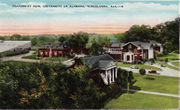
Greek letter organizations first appeared at The University in 1847 when two men visiting from Yale University installed a chapter of Delta Kappa Epsilon. When DKE members began holding secret meetings in the old state capitol building that year, the administration strongly voiced its disapproval. Over the two decades, four other fraternities appeared at Alabama: Phi Gamma Delta in 1855, Sigma Alpha Epsilon in 1856 (this was the founding chapter), Kappa Sigma in 1867, and Sigma Nu in 1874. Anti-fraternity laws were imposed in that year, but were lifted in 1890s. Women at the University founded the Zeta Chapter of Kappa Delta sorority in 1903. Alpha Delta Pi soon followed.
The University today recognizes 48 social Greek letter organizations. An unknown number of unofficial fraternities and sororities also exist. Three governing boards oversee the operations of the Greek organizations: the Interfraternity Council (IFC), the Panhellenic Association, and the National Pan-Hellenic Council (NPHC). There is also a newly established UGC, or Unified Greek Council, which includes those organizations with multicultural membership who are not national members of the latter three Greek boards. Over one quarter of undergraduates at Alabama are now members of a social Greek letter organization. The number of Greek men has more than doubled since 2002 to almost 2,500 for the fall 2008 with 15 fraternities now recording memberships of more than one hundred (within recent years there were none recorded with that number). For the fall 2008 over 3,500 females or 30% of undergraduate females were in a social sorority at UA.[22] Following 2008 fall recruitment, almost all Panhellenic sororities participating through all rounds had potential new member class sizes of 80 or more; nearly all Panhellenic sororities also now have more than 200 total members. In March 2008, the University gained two new sororities to accommodate the growing Greek system interest. Alpha Phi, which had a chapter at the University from 1932 to 1963, colonized in the fall of 2008 and was officially installed as a chapter on April 6, 2009 with its first initiates since 1963. The University of Alabama recently announced they will be adding four new sorority houses to the campus. The new houses will be located behind the President's Mansion and construction is expected to begin Fall 2011.[23]
SGA Controversy
Since its founding in 1914, a secretive coalition of fraternities and sororities, commonly known as "The Machine", has wielded enormous influence over the Student Government Association. Occurrences of harassment, intimidation, and even criminal activities aimed at opposition candidates have been reported. Many figures in local, state and national politics have come out of the SGA at the University of Alabama. (Esquire magazine devoted its April 1992 cover story to an exposé of the Machine.)
Honor societies
|
|
Media
Numerous media outlets are operated by or in conjunction with The University. Student-produced media outlets are all managed by the Office of Student Media, itself controlled by The University-sanctioned Media Planning Board. However, all student publications are editorially independent of The University. The OSM oversees the production of one newspaper, one yearbook, three scholarly publications, and the student-run radio station.
- The Crimson White is the student-produced newspaper. Published four times a week during the normal academic term and once-weekly during the summer term, the CW, as the newspaper is known, normally distributes 15,000 copies per publication.
- First published in 1892, Corolla is the official yearbook of The University. It is produced annually by students and is the oldest student-run publication on campus.
- The Black Warrior Review is The University's widely distributed and influential literary journal managed and published by graduate students (primarily from the English and Creative Writing departments). Founded in 1974, BWR publishes local, regional, and nationally known writers, poets, and visual artists.
- Since 1990, UA has also published the Marr's Field Journal, an undergraduate literary journal published by, and composed of material from, Alabama's undergraduates. Like its "big brother," MFJ publishes fiction, poetry, and graphic art.
- The Southern Historian is a journal of Southern history written, edited, and produced entirely by graduate students in the Department of History. Southern Historian features articles on all aspects of Southern history, culture and book reviews in all fields of U.S. History.
- WVUA-FM, "90.7 The Capstone", formerly known as "New Rock 90.7", is one of the older college radio stations in the nation, tracing its roots back to 1940. It carries a variety of music programming and broadcasts the games of several of the University's sports teams.
- WVUA-CA, also owned by The University and employing numerous students, is a commercial television station run by a professional staff.
Athletics and traditions

Alabama's athletic teams are known as the Crimson Tide. Alabama competes in the Southeastern Conference (Western Division) of the NCAA's Division I. Alabama fields men's teams in football, basketball, baseball, cross country, golf, swimming & diving, tennis and track & field. Women's teams are fielded in basketball, cross country, golf, gymnastics, rowing, soccer, softball, swimming & diving, tennis, track & field and volleyball. The Athletic facilities on campus include the 101,000-seat Bryant-Denny Stadium, named after legendary football coach Paul "Bear" Bryant and former UA President George Denny, and the 14,619-seat Coleman Coliseum.
Alabama maintains athletic rivalries with Auburn University and the University of Tennessee. The rivalry with Auburn is especially heated as it encompasses all sports. The annual Alabama-Auburn football game is nicknamed the Iron Bowl. While the rivalry with Tennessee is centered around football for the most part, there is no shortage of acrimony here, especially given the recent history between then-UT Coach Phillip Fulmer and his relationship to the Tide's most recent NCAA probation. There are also rivalries with Louisiana State University (football and baseball), University of Mississippi (football and men's basketball), Mississippi State University (men's basketball), University of Georgia (women's gymnastics), and the University of Florida (football, softball).
Football
The University of Alabama football program is the most nationally-known of all Alabama's intercollegiate athletics programs. Started in 1892, it is one of the oldest, most tradition-rich, and most successful football programs in the country. The team has won 22 SEC titles and 13 national championships in polls (including 7 awarded by the Associated Press and 5 by the Coaches Poll).[24] Additionally, the team has compiled 30 10-win seasons and 57 bowl appearances, winning 31 of them – all NCAA records. Alabama has produced 18 hall-of-famers (Paul "Bear" Bryant, Harry Gilmer, Bart Starr, Johnny Mack Brown, Johnny Cain, John Hannah, Frank Howard, Pooley Hubert, Lee Roy Jordan, Dixie Howell, Don Hutson, Vaughn Mancha, Johnny Musso, Joe Namath, Ozzie Newsome, Billy Neighbors, Fred Sington, Wallace Wade, Don Whitmire), 97 All-Americans honored 105 times and 1 Heisman trophy winner ( Mark Ingram, Jr.).
The Crimson Tide's current home venue, Bryant-Denny Stadium, opened in 1929 with a capacity of around 12,000. The stadium has since grown to an official capacity of 92,138 via several additions, the latest being an upper deck in the north end zone (completed August 2006). This addition includes a premium club level, an official stadium entrance, and a promenade that is prominently featured in pre-game activities. Bryant-Denny Stadium's all-time attendance record is 92,138, set on September 2, 2006 vs. the University of Hawaii. The Tide has also played many rivalry games, among others, at Legion Field in Birmingham.
Nearly synonymous with Alabama football is legendary coach Paul "Bear" Bryant whose record at The University of Alabama was 232-46-9. He led the Crimson Tide to a national title in 1961, 1964, 1965, 1973, 1978, and 1979, which is tied with Notre Dame's legendary coach Knute Rockne. Additionally, the 1966 team was the only one in the country to finish undefeated and untied, but poll voters denied the 12-0 Alabama team the three-peat as Michigan State and Notre Dame tied each other 10-10 in what was considered the "Game of the Century" and subsequently split the national championship.
On December 12, 2009, sophomore running back Mark Ingram was awarded the Heisman Trophy as college football's best player. In so being named, Ingram became the first Heisman Trophy winner for the University of Alabama. Alabama defeated Texas 37-21 in the BCS Championship game on January 7, 2010, capping a perfect season, a SEC Championship, and winning its first national championship in the BCS era.
Traditions
The most distinctive of Alabama's traditions are almost always associated with football. The nickname "Crimson Tide" originated with the 1907 Iron Bowl. Auburn, heavily favored to win, was forced to accept a tie with Alabama after a hard-fought game. Describing the game, one sportswriter described the offensive line as a "Crimson Tide", in reference to their crimson jerseys.
One such tradition is the fight song, "Yea Alabama", written in 1926 by Lundy Sykes, then editor of the campus newspaper.[25] Its opening line is often sung as "Yea Alabama, Crimson Tide!";[26] however, the correct opening line is "Yea, Alabama! Drown 'em Tide!"[27]
Notable alumni
See also
- Alabama International Trade Center
- Center for Advanced Public Safety
References
- ↑ 1.0 1.1 UA System Financial Report, 2008
- ↑ 2.0 2.1 The University of Alabama. "Brief Profile of The University of Alabama". Press release. http://uanews.ua.edu/2009/09/ua-reaches-record-28807-students/. Retrieved 2009-09-10.
- ↑ 3.0 3.1 3.2 3.3 3.4 Quick Facts. University of Alabama.
- ↑ 4.0 4.1 Center, Clark E. (1990). "The Burning of the University of Alabama". Alabama Heritage Spring 1990 (16): 30–45. http://www.alabamaheritage.com/vault/UAburning.htm.
- ↑ "1963 Year In Review"
- ↑ Frank Moody Music Building (University of Alabama). Woollen, Molzan and Partners, architects/planners web site. Retrieved 2010-7-20.
- ↑ Cain, Mary (July 26, 2007). "Officials: CrimsonRide is ready to get started". The Crimson White.
- ↑ "University of Alabama student enrollment reaches all-time high of 28,807"
- ↑ UA.edu
- ↑ The University of Alabama (April 8, 2006). "UA Announces $500 Million Capital Campaign". Press release. http://ourstudentsourfuture.ua.edu/campaignannouncement.html. Retrieved 2007-11-25.
- ↑ The University of Alabama (November 7, 2007). "UA’s "Our Students. Our Future." Campaign Reaches $428 Million". Press release. http://ourstudentsourfuture.ua.edu/campaignupdate1107.html. Retrieved 2007-11-25.
- ↑ "Our Goals. Our Priorities.". http://ourstudentsourfuture.ua.edu/ourpriorities.html. Retrieved 2007-11-25.
- ↑ "National Universities Rankings". America's Best Colleges 2011. U.S. News & World Report. 2010. http://colleges.usnews.rankingsandreviews.com/college/national-search. Retrieved August 29, 2010.
- ↑ "UA Ranked in Top Tier By U.S. News". http://uanews.ua.edu/anews2005/aug05/usnews081905.htm. Retrieved June 21 2006.
- ↑ University of Alabama. U.S. News & World Report
- ↑ University of Alabama News
- ↑ University of Alabama News
- ↑ Businessweek.com
- ↑ University of Alabama News
- ↑ PRweekus.com
- ↑ 21.0 21.1 "Pains will come with school’s gains, but all will benefit". Tuscaloosa News, September 17, 2007.
- ↑ UA.edu
- ↑ [1]
- ↑ "Past Division I Football Bowl Subdivision (Division I FBS) National Champions (formerly called Division I-A)". NCAA. http://www.ncaa.org/champadmin/ia_football_past_champs.html.
- ↑ Studwell, William Emmett; Bruce R. Schueneman (2001). College Fight Songs II: A Supplementary Anthology. Routledge. p. 21. ISBN 9780789009203. http://books.google.com/books?id=5T_VguL00J0C&pg=RA1-PA21. Retrieved 6 February 2010.
- ↑ Sparks, Linda; Bruce Emerton (1988). American college regalia: a handbook. Greenwood Press. ISBN 9780313262661. http://books.google.com/books?id=FocYAAAAIAAJ&q=%22yea+alabama+crimson+tide%22&dq=%22yea+alabama+crimson+tide%22&client=firefox-a&cd=1. Retrieved 6 February 2010.
- ↑ Songs of Alabama. Rolltide.com.
Bibliography
- [2]. University of Alabama. Accessed 9/10/2009
- Sellers, James B. History of the University of Alabama. Volume 1: 1818–1902. Tuscaloosa (Ala.): University of Alabama Press, 1953. ASIN: B0007ECYJO
- Wolfe, Suzanne Rau. The University of Alabama: A Pictorial History. Tuscaloosa (Ala.): University of Alabama Press, 1983. ISBN 0-8173-0119-4
External links
- Official UA website
- Official Athletics website
- Alabama Maps – Digital Collection of Maps and Aerial Photos from the Geography Department's Cartographic Research Lab
- University of Alabama article in the Encyclopedia of Alabama
|
|||||||||||||||||||||||||||||
|
|||||
|
||||||||
|
|||||||||||